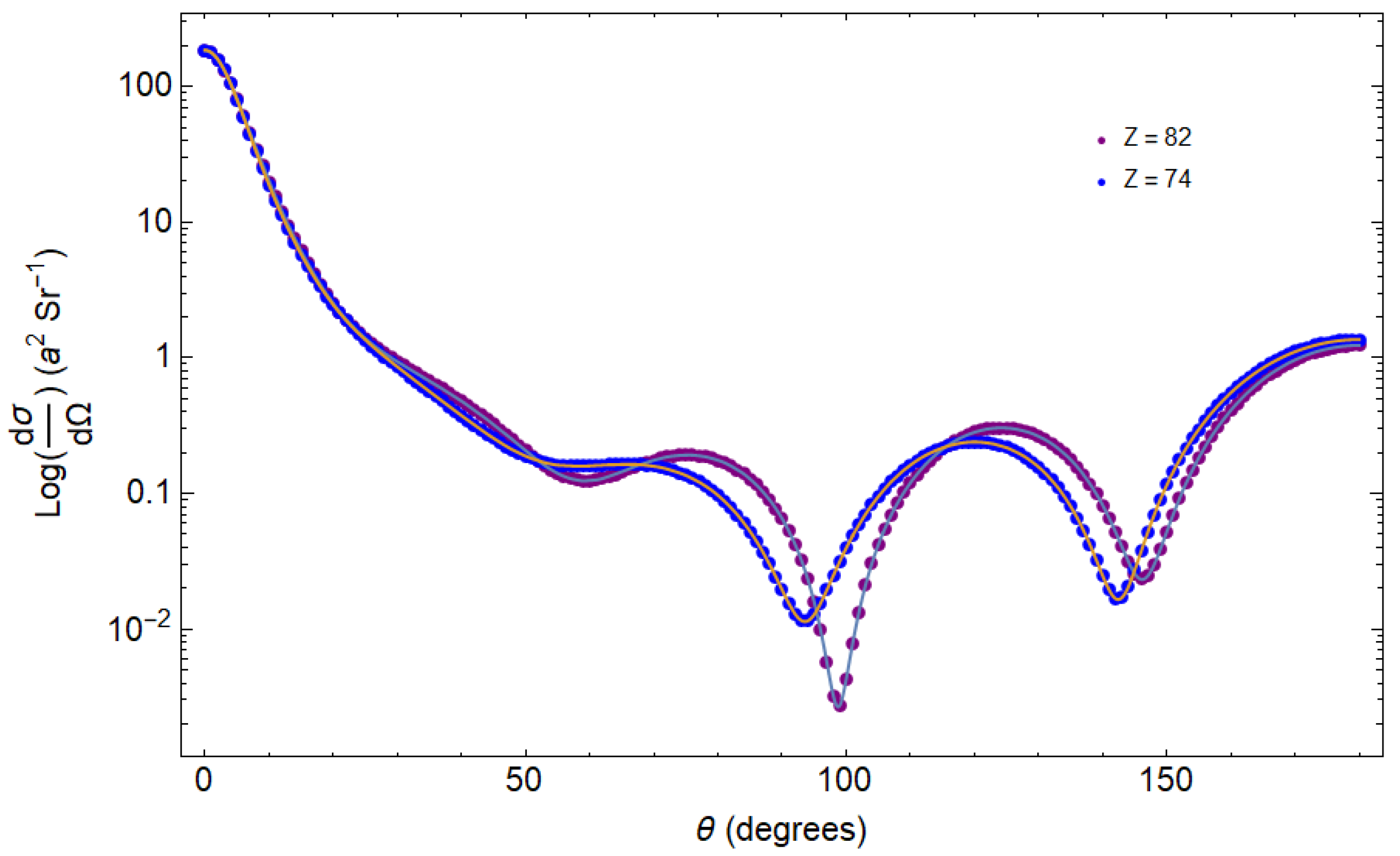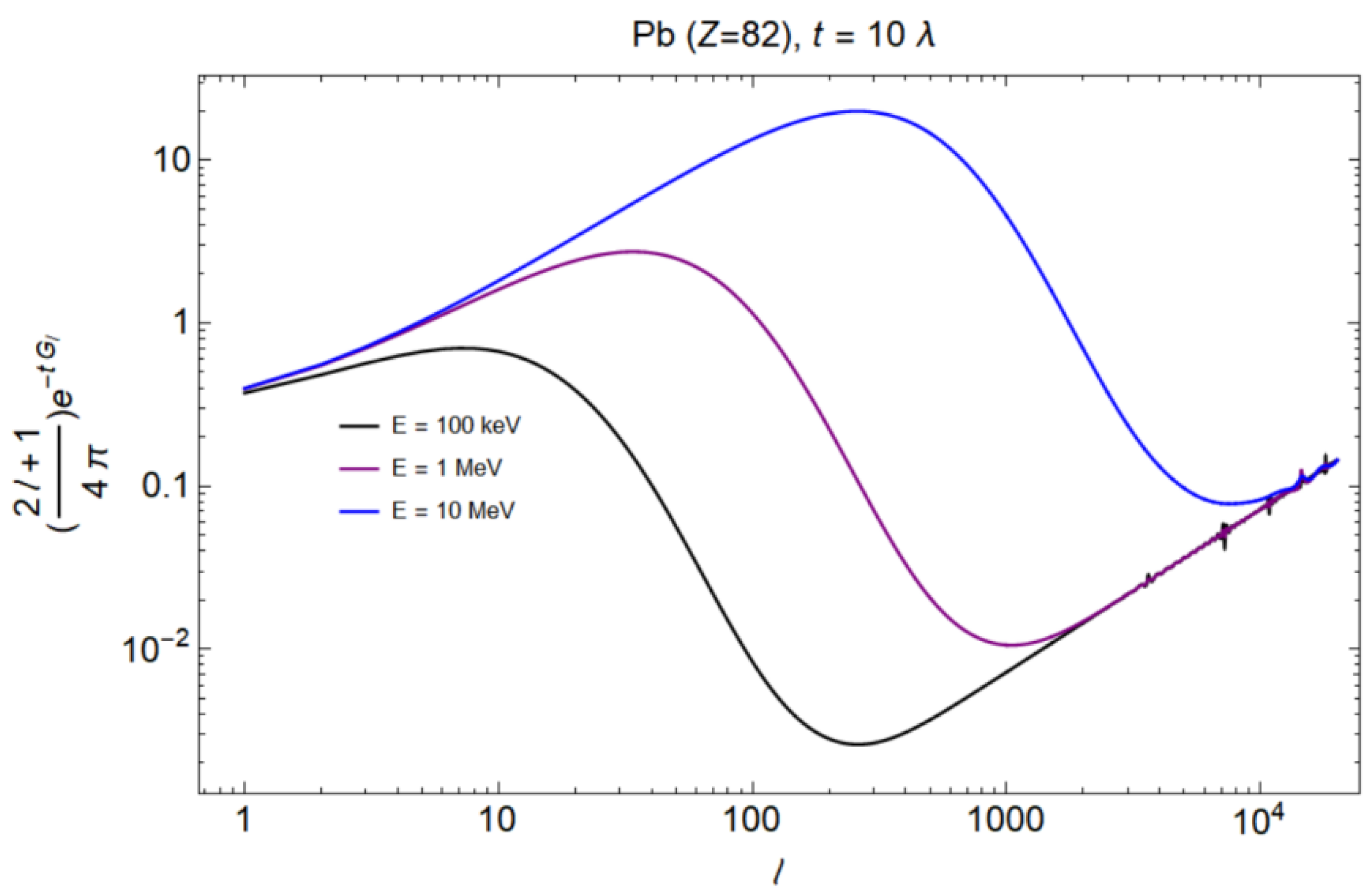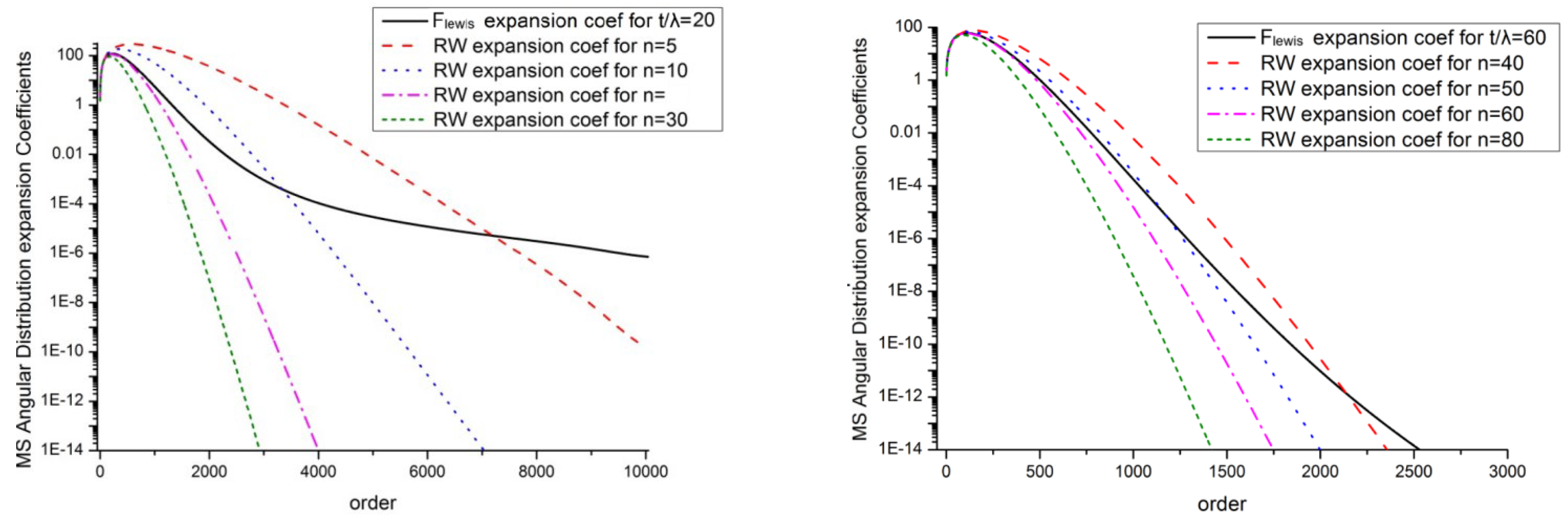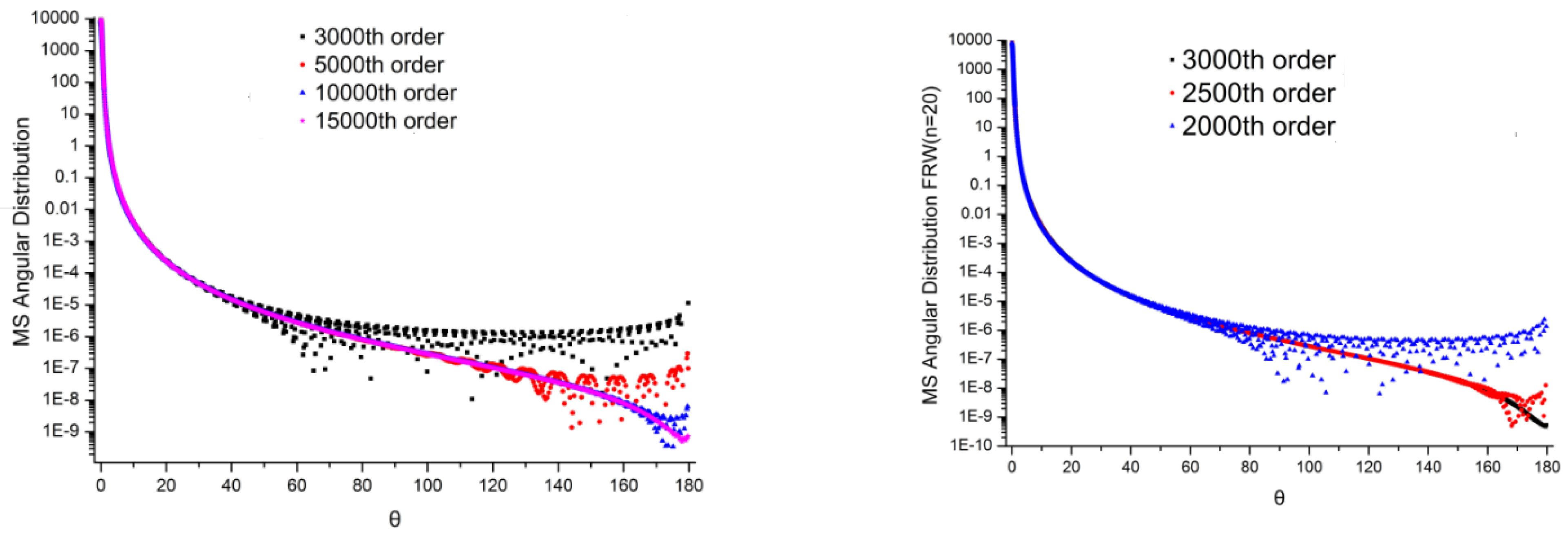Symmetry-Driven Modeling of Electron Multiple Scattering: A Random Walk Approach on the Unit Sphere
Abstract
1. Introduction
2. Multiple Scattering Theories
2.1. Goudsmit–Saunderson Theory of Multiple Scattering
2.2. Lewis Theory of Multiple Scattering
2.3. Random Walk Method and Extension to Lewis Theory
3. Numerical Methods
3.1. Differential Cross-Sections
3.2. Numerical Calculation of Legendre Coefficients and Angular Distribution
3.3. Numerical Simulation
4. Results and Discussion
4.1. Interpolated Differential Cross-Sections
4.2. Legendre Expansion Coefficients
| Algorithm 1. Calculation of Legendre Coefficients (Multiple Scattering Moments): Multiple Scattering Moments () from the 1st to the 20,000th order. | |
| Calculation Method: 2 points Gauss–Legendre quadrature. | |
| Interpolation Method: Log Cubic Spline. | |
| INPUT:T (KE of incident electron in MeV), Z (atomic number Z = 1–95) | |
| OUTPUT: Interpolated Values of elastic differential cross-section. Multiple Scattering Moments (σ ). Angular distribution of Multiple scattering. | |
| 1 | START |
| 2 | INTERPdcs (Z, T, ) gives interpolated values of elastic differential cross-sections which are calculated by the Log-Cubic Spline method. |
| 3 | function MSdistribution (Z, T) |
| 4 | define |
| 5 | ; |
| 6 | ; |
| 7 | in terms of mean free path (mfp) |
| 8 | ; |
| 9 | |
| 10 | → |
| 11 | (* 606 angles points*) |
| 12 | |
| 13 | →end |
| 14 | |
| 15 | end |
| 16 | End |
4.3. Multiple Scattering Angular Distributions; Comparison with Random Walk Method
4.4. Validation Metrics
- (1)
- 1/e width of the angular distribution:
- (2)
- Computational efficiency:
5. Conclusions
Author Contributions
Funding
Data Availability Statement
Acknowledgments
Conflicts of Interest
References
- Berger, M.J. Monte Carlo Calculations of the Penetration and Diffusion of Fast Charged Particles. In Methods in Computational Physics; Alder, B., Fernbach, S., Rotenberg, M., Eds.; Academic Press: New York, NY, USA, 1963; Volume 1, pp. 135–215. [Google Scholar]
- Williams, E.J. Multiple Scattering of Fast Electrons and Alpha-Particles, and “Curvature” of Cloud Tracks Due to Scattering. Phys. Rev. 1940, 58, 292. [Google Scholar] [CrossRef]
- Moliere, G. Theorie der Streuung schneller geladener Teilchen II Mehrfach-und Vielfachstreuung. Z. Naturforschung A 1948, 3, 78–97. [Google Scholar] [CrossRef]
- Bethe, H.A. Molière’s Theory of Multiple Scattering. Phys. Rev. 1953, 89, 1256–1266. [Google Scholar] [CrossRef]
- Snyder, H.S.; Scott, W.T. Multiple Scattering of Fast Charged Particles. Phys. Rev. 1949, 76, 220. [Google Scholar] [CrossRef]
- Strong, I.B.; Roy, R.R. Multiple Scattering of Electrons and Positrons. Phys. Rev. 1963, 131, 198. [Google Scholar] [CrossRef]
- Goudsmit, S.; Saunderson, J.L. Multiple Scattering of Electrons. Phys. Rev. 1940, 57, 24–29. [Google Scholar] [CrossRef]
- Goudsmit, S.; Saunderson, J.L. Multiple Scattering of Electrons. II. Phys. Rev. 1940, 58, 36–42. [Google Scholar] [CrossRef]
- Lewis, H.W. Multiple Scattering in an Infinite Medium. Phys. Rev. 1950, 78, 526–529. [Google Scholar] [CrossRef]
- Ross, C.K.; McEwen, M.R.; McDonald, A.F.; Cojocaru, C.D. Measurement of Multiple Scattering of 13 and 20 MeV Electrons by Thin Foils. Med. Phys. 2008, 35, 4121–4130. [Google Scholar] [CrossRef]
- Dixon, D.A.; Hughes, H.G. Validation of the MCNP6 Electron-Photon Transport Algorithm: Multiple-Scattering of 13- and 20-MeV Electrons in Thin Foils. EPJ Web Conf. 2017, 153, 04003. [Google Scholar] [CrossRef]
- Scott, W.T. The Theory of Small-Angle Multiple Scattering of Fast Charged Particles. Rev. Mod. Phys. 1963, 35, 231–313. [Google Scholar] [CrossRef]
- Seltzer, S.M. An Overview of ETRAN Monte Carlo Methods. In Monte Carlo Transport of Electrons and Photons; Jenkins, T.M., Nelson, W.R., Rindi, A., Nahum, A.E., Rogers, D.W.O., Eds.; Plenum Press: New York, NY, USA, 1988; pp. 21–56. [Google Scholar] [CrossRef]
- Agostinelli, S.; Allison, J.; Amako, K.; Apostolakis, J.; Araujo, H.; Arce, P.; Asai, M.; Axen, D.; Banerjee, S.; Barrand, G.; et al. Geant4—A Simulation Toolkit. Nucl. Instrum. Methods Phys. Res. A 2003, 506, 250–303. [Google Scholar] [CrossRef]
- Sempau, J.; Baró, J.; Fernández-Varea, J.; Salvat, F. PENELOPE: An algorithm for Monte Carlo simulation of the penetration and energy loss of electrons and positrons in matter. Nucl. Instrum. Methods Phys. Res. Sect. B Beam Interact. Mater. At. 1995, 100, 31–46. [Google Scholar] [CrossRef]
- Salvat, F. Simulation of Electron Multiple Elastic Scattering. Radiat. Phys. Chem. 1998, 53, 247–271. [Google Scholar] [CrossRef]
- Hirayama, H.; Namito, Y.; Bielajew, A.F.; Wilderman, S.J.; Nelson, W.R. The EGS5 Code System; SLAC-R-730; Stanford Linear Accelerator Center: Stanford, CA, USA, 2005. [Google Scholar]
- Kawrakow, I.; Rogers, D.W.O. The EGSnrc Code System: Monte Carlo Simulation of Electron and Photon Transport; PIRS-701; National Research Council Canada: Ottawa, ON, Canada, 2000. [Google Scholar]
- Kawrakow, I. Accurate Condensed History Monte Carlo Simulation of Electron Transport. I. EGSnrc, the New EGS4 Version. Med. Phys. 2000, 27, 485–498. [Google Scholar] [CrossRef]
- Negreanu, C.; Llovet, X.; Chawla, R.; Salvat, F. Calculation of Multiple-Scattering Angular Distributions of Electrons and Positrons. Radiat. Phys. Chem. 2005, 74, 264–281. [Google Scholar] [CrossRef]
- Kawrakow, I.; Bielajew, A.F. On the Representation of Electron Multiple Elastic-Scattering Distributions for Monte Carlo Calculations. Nucl. Instrum. Methods Phys. Res. B 1998, 134, 325–336. [Google Scholar] [CrossRef]
- Kadri, O.; Ivanchenko, V.; Gharbi, F.; Trabelsi, A. Incorporation of the Goudsmit–Saunderson Electron Transport Theory in the Geant4 Monte Carlo Code. Nucl. Instrum. Methods Phys. Res. B 2009, 267, 2975–2981. [Google Scholar] [CrossRef]
- Peterson, M.A. Angular Distributions in Multiple Scattering. Phys. Rev. A 1983, 28, 135–142. [Google Scholar] [CrossRef]
- Wasaye, M.A.; Qi, H.; Zhang, X. The Hybrid Model for Sampling Multiple Elastic Scattering Angular Deflections Based on Goudsmit-Saunderson Theory. Nucl. Technol. Radiat. Prot. 2017, 32, 229–239. [Google Scholar] [CrossRef]
- Wasaye, M.A.; Yu, T.; Ni, Z. An Efficient Convergence Method for Calculating the Angular Distribution of Electron Multiple Elastic Scattering. J. Korean Phys. Soc. 2023, 82, 742–751. [Google Scholar] [CrossRef]
- Roberts, P.H.; Ursell, H.D. Random Walk on a Sphere and on a Riemannian Manifold. Philos. Trans. R. Soc. Lond. A 1960, 252, 317–356. [Google Scholar] [CrossRef]
- Berger, M.J.; Wang, R. Multiple-Scattering Angular Deflections and Energy—Loss Straggling. In Monte Carlo Transport of Electrons and Photons; Ettore Majorana International Science Series, Jenkins, T.M., Nelson, W.R., Rindi, A., Eds.; Springer: Boston, MA, USA, 1988; Volume 38. [Google Scholar] [CrossRef]
- Salvat, F.; Jablonski, A.; Powell, C.J. ELSEPA—Dirac Partial-Wave Calculation of Elastic Scattering of Electrons and Positrons by Atoms, Positive Ions, and Molecules. Comput. Phys. Commun. 2005, 165, 157–190. [Google Scholar] [CrossRef]






| Parameter | Lewis Theory | Random Walk | % Difference |
|---|---|---|---|
| θ1/e (Degrees) | 9.605 | 9.654 | 0.52% |
| Computation Time (ms) | 1850 | 320 | 82.7% |
Disclaimer/Publisher’s Note: The statements, opinions and data contained in all publications are solely those of the individual author(s) and contributor(s) and not of MDPI and/or the editor(s). MDPI and/or the editor(s) disclaim responsibility for any injury to people or property resulting from any ideas, methods, instructions or products referred to in the content. |
© 2025 by the authors. Licensee MDPI, Basel, Switzerland. This article is an open access article distributed under the terms and conditions of the Creative Commons Attribution (CC BY) license (https://creativecommons.org/licenses/by/4.0/).
Share and Cite
Ni, Z.; Wasaye, M.A.; Siddique, I.; Peng, Z.; Saeed, M. Symmetry-Driven Modeling of Electron Multiple Scattering: A Random Walk Approach on the Unit Sphere. Symmetry 2025, 17, 945. https://doi.org/10.3390/sym17060945
Ni Z, Wasaye MA, Siddique I, Peng Z, Saeed M. Symmetry-Driven Modeling of Electron Multiple Scattering: A Random Walk Approach on the Unit Sphere. Symmetry. 2025; 17(6):945. https://doi.org/10.3390/sym17060945
Chicago/Turabian StyleNi, Zining, Muhammad Abdul Wasaye, Irfan Siddique, Zhiqiang Peng, and Mohsin Saeed. 2025. "Symmetry-Driven Modeling of Electron Multiple Scattering: A Random Walk Approach on the Unit Sphere" Symmetry 17, no. 6: 945. https://doi.org/10.3390/sym17060945
APA StyleNi, Z., Wasaye, M. A., Siddique, I., Peng, Z., & Saeed, M. (2025). Symmetry-Driven Modeling of Electron Multiple Scattering: A Random Walk Approach on the Unit Sphere. Symmetry, 17(6), 945. https://doi.org/10.3390/sym17060945







